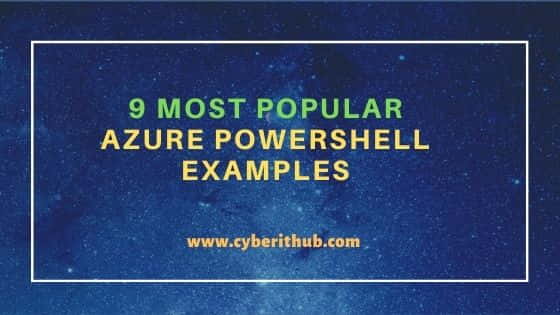Table of Contents
In this article, i will take you through 9 Most Popular Azure Powershell Examples. Microsoft Azure (formerly Windows Azure) is a cloud computing service provided by Microsoft. Azure provides the platform and infrastructure to deploy and manage applications and services through a global network of datacenters.

Azure Powershell Examples
Also Read: Create Virtual Machine in Azure with Just 7 Easy Steps
1. Install Azure Powershell Modules
First you need to install azure Powershell modules using below command to connect Microsoft Azure.
PS C:\> Install-Module -Name Az -AllowClobber -Scope AllUsers
Untrusted repository You are installing the modules from an untrusted repository. If you trust this repository, change its InstallationPolicy value by running the Set-PSRepository cmdlet. Are you sure you want to install the modules from 'PSGallery'? [Y] Yes [A] Yes to All [N] No [L] No to All [S] Suspend [?] Help (default is "N"): A
2. Connect Microsoft Azure
Once Azure module is installed through azure powershell command, you can connect microsoft azure Cloud by using Connect-AzureRMAccount command as shown below.
PS C:\> Connect-AzureRMAccount
Account SubscriptionName TenantId Environment
------- ---------------- -------- -----------
test@example.com Microsoft Azure Enterprise 9187989-8c5e-41d4-82e8-3d1bfjh67b2f AzureCloud
3. Get Azure Tenant
If you want to check all the tenant authorized for the current logged in user, you can check it by using Azure powershell Get-AzureRMTenant command as shown below.
PS C:\> Get-AzureRMTenant
Id Directory
-- ---------
91d27ab9-8c5e-41d4-82e8-3d1bf81fcb2f example.com
4. Disconnect Azure Account
If you want to disconnect from Microsoft Azure account, you can disconnect it by using Disconnect-AzureRMAccount command.
PS C:\> Disconnect-AzureRMAccount
Id : test@example.com
Type : User
Tenants : {91d27ab9-8c5e-41d4-82e8-3d1bf81fcb2f}
AccessToken :
Credential :
TenantMap : {}
CertificateThumbprint :
ExtendedProperties : {[Subscriptions, 69cbf2fc-73ff-4ad1-80b4-0e83f418491d], [Tenants, 91d27ab9-8c5e-41d4-82e8-3d1bf81fcb2f]}
5. List all the Resources in Current Subscription
If you want to List all the resources in the current subscription, then you need to use Get-AzureRmResource Azure Powershell command to list it as shown below.
PS C:\> Get-AzureRmResource | ft
Name ResourceGroupName
---- -----------------
azureOsDisk_1_840e9f588eab424d93364145afc65ccf TestMP
Instance-DataDisk_0 TestMP
Instance-OsDisk_1_fa64d020239yhge8b5c648f765ec4c8e TestMP
instance_disk1_c42cbefc4965487jh9e3b319bca033dc TestMP
example-disk1_1cd093db7adcnk7jfa9f2f2be4770e73 TestMP
test0_DataDisk_0 TestMP
test0_OsDisk_1_c8d7d43ea7f243a9ui89j48b66998b3e TestMP
test1_DataDisk_0 TestMP
test1_OsDisk_1_2925e1774ce045b6b6cad9bdaaf91691 TestMP
test2_DataDisk_0 TestMP
test2_OsDisk_1_f81916f00ea646b5ab6cf27c8955cef0 TestMP
test_disk1_02f6bc0e047148c7ba52063f26216ad2 TestMP
OsDisk_1_445173ba53dc4e8jf5430d272b41e007 TestMP
Instance_OsDisk_1_099b948d43e4421c9af52d3f6d022bf4 TestMP
Instance_OsDisk_1_fa28d97c9jhg675hd4e7ebe289a164a0 TestMP
image TestMP
6. List all resources in a Resource Group
If you want to list all the resources of a particular Resource Group, then you can use -ResourceGroupName option with Get-AzureRMResource command to check that.
PS C:\> Get-AzureRMResource -ResourceGroupName azureMP | ft
Name ResourceGroupName ResourceType
---- ----------------- ------------
test11-inyOsDisk_1_840e9f588eab424d93364145afc65ccf TestMP Microsoft.Compute/disks
example-test-98714hgkjDataDisk_0 TestMP Microsoft.Compute/disks
test0989_hjhyt_disk_exOsDisk_1_fa64d020239b4be8b TestMP Microsoft.Compute/disks
instance_disk1_c42cbejhuy76fg54rfc4965443b89e3b TestMP Microsoft.Compute/disks
disk1_1cd093db7aklo0983ddc40fb9a9f2f2be4770e73 TestMP Microsoft.Compute/disks
test0_DataDisk_0 TestMP Microsoft.Compute/disks
test0_Oskjsk_1_c8d7d43ea7f243a9a00c748b66998b3e TestMP Microsoft.Compute/disks
test1_DjhlDisk_0 TestMP Microsoft.Compute/disks
test1_Os78sk_1_2925e1774cjhukjufread9bdaaf91691 TestMP Microsoft.Compute/disks
test2_oa98Disk_0 TestMP Microsoft.Compute/disks
test2_psDisk_1_f81916f00eklkjjhtydcf27c8955cef0 TestMP Microsoft.Compute/disks
test-908765th_disk1_02fkjhjiutyujkh8c7ba52063f26216ad2 TestMP Microsoft.Compute/disks
7. List all the Resource Providers
If you want to list all the resource providers, then you need to use Get-AzureRMResourceProvider command as shown below.
PS C:\> Get-AzureRMResourceProvider | ft
ProviderNamespace RegistrationState ResourceTypes
----------------- ----------------- -------------
Microsoft.Security Registered {operations, securityStatuses, tasks, regulatoryComplianceStandard...
Microsoft.Compute Registered {availabilitySets, virtualMachines, virtualMachines/extensions, vi...
Microsoft.Network Registered {virtualNetworks, publicIPAddresses, networkInterfaces, privateEnd...
Microsoft.Storage Registered {storageAccounts, operations, locations/asyncoperations, storageAc...
Microsoft.ResourceHealth Registered {availabilityStatuses, childAvailabilityStatuses, childResources, ...
Microsoft.PolicyInsights Registered {policyEvents, policyStates, operations, asyncOperationResults...}
Microsoft.ManagedIdentity Registered {Identities, userAssignedIdentities, operations}
8. List all Azure Locations
If you want to list all the Microsoft Azure Locations, then you can use Get-AzureRMLocation command and list it as shown below.
PS C:\> Get-AzureRMLocation | ft
Location DisplayName Providers
-------- ----------- ---------
eastasia East Asia {Microsoft.Security, Microsoft.Compute, Microsoft.Network, Microsoft.Storage...
southeastasia Southeast Asia {Microsoft.Security, Microsoft.Compute, Microsoft.Network, Microsoft.Storage...
centralus Central US {Microsoft.Security, Microsoft.Compute, Microsoft.Network, Microsoft.Storage...
eastus East US {Microsoft.Security, Microsoft.Compute, Microsoft.Network, Microsoft.Storage...
eastus2 East US 2 {Microsoft.Security, Microsoft.Compute, Microsoft.Network, Microsoft.Storage...
westus West US {Microsoft.Security, Microsoft.Compute, Microsoft.Network, Microsoft.Storage...
northcentralus North Central US {Microsoft.Security, Microsoft.Compute, Microsoft.Network, Microsoft.Storage...
southcentralus South Central US {Microsoft.Security, Microsoft.Compute, Microsoft.Network, Microsoft.Storage...
northeurope North Europe {Microsoft.Security, Microsoft.Compute, Microsoft.Network, Microsoft.Storage...
9. List Azure Role Definition
If you want to list all the Azure role definitions, then you need to use Azure Powershell Get-AzureRMRoleDefinition command as shown below.
PS C:\> Get-AzureRMRoleDefinition | ft
Name Id IsCustom Description
---- -- -------- -----------
AcrPush 8311e382-0749-4cb8-b61a-304f252e45ec False acr push
API Management Service Contributor 312a565d-c81f-4fd8-895a-4e21e48d571c False Can manage servic...
AcrPull 7f951dda-4ed3-4680-a7ca-43fe172d538d False acr pull
AcrImageSigner 6cef56e8-d556-48e5-a04f-b8e64114680f False acr image signer
AcrDelete c2f4ef07-c644-48eb-af81-4b1b4947fb11 False acr delete
AcrQuarantineReader cdda3590-29a3-44f6-95f2-9f980659eb04 False acr quarantine da...
AcrQuarantineWriter c8d4ff99-41c3-41a8-9f60-21dfdad59608 False acr quarantine da...
API Management Service Operator Role e022efe7-f5ba-4159-bbe4-b44f577e9b61 False Can manage servic...
API Management Service Reader Role 71522526-b88f-4d52-b57f-d31fc3546d0d False Read-only access ...
Application Insights Component Contributor ae349356-3a1b-4a5e-921d-050484c6347e False Can manage Applic...
Application Insights Snapshot Debugger 08954f03-6346-4c2e-81c0-ec3a5cfae23b False Gives user permis...
Also Read: Automating Microsoft Azure with Powershell
